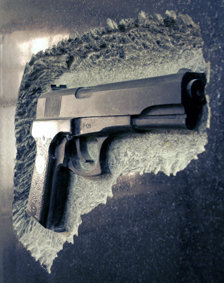Marcus Wittmers
dal 4/9/2008 al 10/10/2008
Segnalato da
4/9/2008
Marcus Wittmers
Gitte Weise Gallery, Berlin
Between ceasefire and table football

Compared with other media in contemporary art,
stone sculptures and casts seem oddly
old-fashioned. Marcus Wittmers's works are
meticulously handcrafted, an intricate process
that is both long and involved. The use of the
stone, the marks left from working it, the sheer
weight and solidity of the material all provide a
physical embodiment of the complex emotional
issues of cultural history contained in his work.
Marcus Wittmers gives expression to these ideas
whilst at the same time imbuing his sculptures
with a contemporary edge.
These ideas can be associated with duration,
eternity, death, etc. - terms that are rarely
used or present in modern everyday speech. In
Waffenruhe (Ceasefire; a series the artist has
been working on since the year 2000), the ideas
appear with great clarity due to the use of
gravestones carved open to reveal almost
hyper-realistic images of handguns of types used
all over the world today. With this clearly
executed shifting of context (the stones are
salvaged from waste piles in Berlin's
cemeteries), the artist gives access to various
levels of intellectual interpretation of the work.
On one hand, the sculptures are surprising, as
somehow, these menacing pistols on the rough
surface of the stone look seductive with their
skilful and precise reproduction. To achieve this
effect, the Berlin artist uses Belgian granite, a
material which reproduces the colour and texture
of the weapons strikingly realistically. On the
other hand, the pleasure of the moment is also
filled with its dark side - fleetingness, death,
finality. The graves and pistols reveal this
unsettling dimension, and in turn because of the
title Ceasefire, are given what one would almost
like to describe as a physical and poetic
serenity, hope-inspiring closure: may the weapons
be laid to rest.
Furthermore, the work can be interpreted
culturally and sociologically, by exclusively
connecting every weapon (each always has
individual, unique features) to a gravestone, as
a sign of a life once lived. Television today is
riddled with armed figures, hijackers and people
under threat - a culture of violence and fear.
This could be brushed aside as a reflection of
modern media and its daily struggle for attention
and thrills. But is it really?
With this artistic strategy involving shifting
contexts, the use of remnants of the Pathos
formula of cultural history and the tenuous
position of traditional sculptural mediums,
Wittmers creates ripples in modern culture's
surface and depths, its aesthetic pleasures and
various discourses. He continues the long
tradition of the obelisk, of talking stones,
symbols connecting the upper and lower planes.
In this exhibition, the work Kicker towers over
visitors and a toy overpowers them. But what
appears to be heavy is deceptively light; nothing
is as it appears. This work is based on Kicker -
table football - which was extremely widespread
in amusement arcades, pubs and later in youth
clubs until well into the 1980s. The golden age
for this toy seems to have waned along with the
end of these social meeting-places. In our modern
entertainment industry it is increasingly
becoming an anachronism with the domination of
electronic media. Almost everyone is familiar
with the game, which is why the contradictions
proposed by the floating figure (who is being
overpowered here, and why?) are mixed with highly
individual memories of the viewer's own youth,
celebrations and games. Social interpretations
can be made with regard to Marcus Wittmers's
artistic concept e.g. the footballer as a
modern-day hero. Finally however Waffenruhe and
Kicker are unexpectedly connected by violence as
the game was originally created as an exercise
device for injured soldiers to practise their
fine motor skills.
Opening sept. 5, 2008
Gitte Weise Gallery
Tucholskystrasse 47 - Berlin
Free admission



